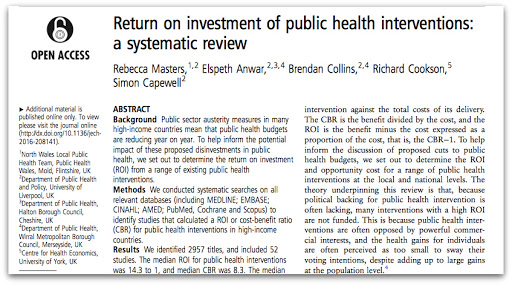In a recent New England Journal of Medicine Sounding Board article, Karen Emmons and Cancer News in Context’s Graham Colditz detailed the well-established health and economic benefits of disease prevention programs. One example they highlighted was the more than double return on investment (ROI) of dollars put towards a tobacco cessation program in Massachusetts.
Now, a new systematic review by Rebecca Masters and fellow researchers in the United Kingdom shows that that very good doubling of ROI may actually be on the low end of returns when it comes to the positive economic benefits of many public health interventions. Looking at published studies on interventions as varied as speed limits, needle exchange, soda taxes, vaccination, medication adherence, and tobacco cessation, the researchers found that the average ROI across all such interventions was 14. This means that for every dollar invested in the reviewed public health programs, 14 dollars (plus the initial dollar invested) was saved.
While a small number of individual studies in the review showed a negative ROI, the vast majority found positive results, with some very large, such as the ROI for sugary soda tax legislation. The table below highlights some of the individual studies used to calculate the overall ROI for the public health interventions.
| Selected interventions (single study results) | ROI | ||||
| Sugar-sweetened beverage tax | $55.00 | ||||
| Tobacco cessation (pregnant women) | $6.72 – 17.18 | ||||
| Workplace health management | $4.51 | ||||
| Cycling & walking trails | $2.94 | ||||
| Universal Hepatitis B vaccination | $2.98 | ||||
| Tobacco cessation (general) | $2 – 2.25 | ||||
With such large and consistent findings of economic benefit, it is hard to understand why such health programs need to fight so hard for adequate funding. As the authors write, “even with the most rudimentary economic evaluations, it was clear that most public health intervention are substantially cost saving.”
Unfortunately, success in public health can take time and it can feel muted next to flashier news items – both of which can hamper funding efforts. To capitalize on these numbers – to realize the potential of their great return on investment – we need to find a way to effectively tell our stories, to build public interest, and to garner the political will to fund public health appropriately. The economic and health benefits could be enormous. We should not leave them on the table.

